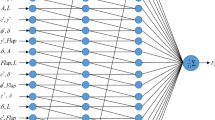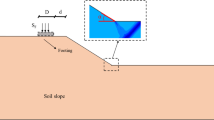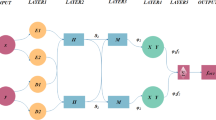Abstract
In this study, five nonlinear prediction tools are used to model and predict the friction capacity of driven piles installed in clay including classical support vector machine (SVM) and two of its variants, namely regularized generalized proximal SVM and twin SVM, adaptive neuro-fuzzy inference system (ANFIS) and genetic programming (GP). The undrained shear strength, effective vertical stress, pile diameter and pile length are taken as the input parameters of the developed models, and the friction capacity is considered as the output. A total of 80 experimental observations are collected and used to train and test several models estimating the friction capacity of a driven pile in clay. The results demonstrate that, noting the root-mean-square error (RMSE) value, for prediction of the friction capacity of driven piles in clay the ANFIS model gives a better convergence to the in situ results, compared with the GP and SVM models. The developed ANFIS model provided a simple and reliable design structure for proper selection of the pile friction capacity of driven piles installed in clay. Furthermore, a simple mathematical formula is presented based on the GP model. The predicted results are compared with in situ data set models to demonstrate the abilities of the AI models. In order to perform a model evaluation, in addition to RMSE, the regression coefficient of determination is obtained through testing and training of the SVM, ANFIS and GP models. The results show high reliability for the developed models. The presented ANFIS and GP models are introduced as new models in the field of geotechnical engineering.












Similar content being viewed by others
References
Esrig MI, Kirby RC, Murphy BS (1981) Advances in general effective stress method for prediction of axial capacity for driven piles in clay. J Pet Technol 33(9):1793–1802
McVay MC, Birgisson B, Zhang LM, Perez A, Putcha S (2000) Load and resistance factor design (LRFD) for driven piles using dynamic methods—a Florida perspective. Geotech Test J 23(1):55–66
Yang L, Liang R (2006) Incorporating set-up into reliability-based design of driven piles in clay. Can Geotech J 43(9):946–955
Seo H, Yildirim IZ, Prezzi M (2009) Assessment of the axial load response of an H pile driven in multilayered soil. J Geotech Geoenviron Eng 135(12):1789–1804
Kim D, Lee J (2012) Resistance factor contour plot analyses of load and resistance factor design of axially-loaded driven piles in clays. Comput Geotech 44:9–19
Fattah MY, Al-Mosawi MJ, Al-Zayadi AAO (2013) Time dependent behavior of piled raft foundation in clayey soil. Geomech Eng 5(1):17–36
Afshin A, Rayhani MT (2015) Evaluation of bearing capacity with time for small-scale piles driven into Leda clay. Int J Geotech Eng 9(3):307–315
Saye SR, Lutenegger AJ, Brown DA, Kumm BP (2016) Influence of sample disturbance on estimated side resistance of driven piles in cohesive soils. J Geotech Geoenviron Eng 142(10):11
Aksoy HS, Gor M, Inal E (2016) A new design chart for estimating friction angle between soil and pile materials. Geomech Eng 10(3):315–324
Xia TA, Wang W, Wang XN (2010) Artificial neural network model for time-dependent vertical bearing capacity of preformed concrete pile. In: Tan HH (ed) Applied mechanics and mechanical engineering, pts 1–3. Trans Tech Publications Ltd, Stafa-Zurich, pp 226–230
Park HI, Cho CW (2010) Neural network model for predicting the resistance of driven piles. Mar Georesour Geotechnol 28(4):324–344
Liang BL, Gao Y, Zhu L, Lv GB, Li X (2005) Prediction of pile displacement using PSO algorithm and artificial neural networks. China Univ Geosciences Press, Wuhan
Ismail A, Jeng DS (2011) Modelling load-settlement behaviour of piles using high-order neural network (HON-PILE model). Eng Appl Artif Intell 24(5):813–821
Das SK, Basudhar PK (2006) Undrained lateral load capacity of piles in clay using artificial neural network. Comput Geotech 33(8):454–459
Hanna AM, Morcous G, Helmy M (2004) Efficiency of pile groups installed in cohesionless soil using artificial neural networks. Can Geotech J 41(6):1241–1249
Kiefa MA (1998) General regression neural networks for driven piles in cohesionless soils. J Geotech Geoenviron Eng 124(12):1177–1185
Dung NT, Chung SG, Kim SR, Beak SH (2011) Applicability of the SPT-based methods for estimating toe bearing capacity of driven PHC piles in the thick deltaic deposits. KSCE J Civ Eng 15(6):1023–1031
Kumara JJ, Kikuchi Y, Kurashina T, Hyodo T (2016) Base resistance of open-ended piles evaluated by various design methods. Int J GEOMATE 11(26):2643–2650
Goh ATC (1996) Pile driving records reanalyzed using neural networks. J Geotech Eng ASCE 122(6):492–495
Che WF, Lok TMH, Tam SC, Novais-Ferreira H (2003) Axial capacity prediction for driven piles at Macao using artificial neural network. A A Balkema Publishers, Leiden
Park HI, Seok JW, Hwang DJ (2006) Hybrid neural network and genetic algorithm approach to the prediction of bearing capacity of driven piles. Taylor & Francis Ltd, London
Samui P (2008) Prediction of friction capacity of driven piles in clay using the support vector machine. Can Geotech J 45(2):288–295
Xia T, Wang W (2009) Study on evaluating methods for time-dependent ultimate bearing capacity of single driven pile. IEEE Computer Soc, Los Alamitos
Shahin MA (2010) Intelligent computing for modeling axial capacity of pile foundations. Can Geotech J 47(2):230–243
Samui P (2011) Multivariate adaptive regression spline applied to friction capacity of driven piles in clay. Geomech Eng 3(4):285–290
Samui P (2012) Determination of ultimate capacity of driven piles in cohesionless soil: a multivariate adaptive regression spline approach. Int J Numer Anal Meth Geomech 36(11):1434–1439
Milad F, Kamal T, Nader H, Erman O (2015) New method for predicting the ultimate bearing capacity of driven piles by using Flap number. KSCE J Civ Eng 19(3):611–620
Hung LC, Nguyen TD, Lee JH, Kim SR (2016) Applicability of CPT-based methods in predicting toe bearing capacities of driven piles in sand. Acta Geotech 11(2):359–372
Suman S, Das SK, Mohanty R (2016) Prediction of friction capacity of driven piles in clay using artificial intelligence techniques. Int J Geotech Eng 10(5):469–475
Zhang Y, Wang S, Phillips P, Dong Z, Ji G, Yang J (2015) Detection of Alzheimer’s disease and mild cognitive impairment based on structural volumetric MR images using 3D-DWT and WTA-KSVM trained by PSOTVAC. Biomed Signal Process Control 21:58–73
Wang S-H, Phillips P, Dong Z-C, Zhang Y-D (2018) Intelligent facial emotion recognition based on stationary wavelet entropy and jaya algorithm. Neurocomputing 272:668–676
Wang S, Phillips P, Liu A, Du S (2017) Tea category identification using computer vision and generalized eigenvalue proximal svm. Fundam Inform 151(1–4):325–339
Vapnik V (2013) The nature of statistical learning theory. Springer, Berlin
Khemchandani R, Karpatne A, Chandra S (2011) Generalized eigenvalue proximal support vector regressor. Expert Syst Appl 38(10):13136–13142
Peng X (2010) TSVR: an efficient twin support vector machine for regression. Neural Netw 23(3):365–372
Khemchandani R, Goyal K, Chandra S (2016) TWSVR: regression via twin support vector machine. Neural Netw 74:14–21
Jang J-S, Sun C-T (1995) Neuro-fuzzy modeling and control. Proc IEEE 83(3):378–406
Koza JR (1992) Genetic programming: on the programming of computers by means of natural selection. MIT Press, London
Author information
Authors and Affiliations
Corresponding authors
Ethics declarations
Conflict of interest
The authors declare that there is no conflict of interest in presenting this manuscript.
Rights and permissions
About this article
Cite this article
Moayedi, H., Hayati, S. Artificial intelligence design charts for predicting friction capacity of driven pile in clay. Neural Comput & Applic 31, 7429–7445 (2019). https://doi.org/10.1007/s00521-018-3555-5
Received:
Accepted:
Published:
Issue Date:
DOI: https://doi.org/10.1007/s00521-018-3555-5




